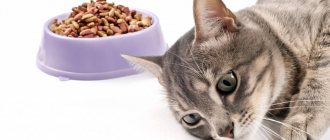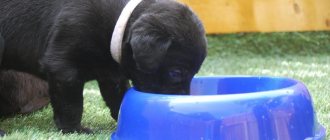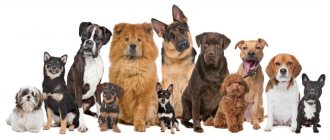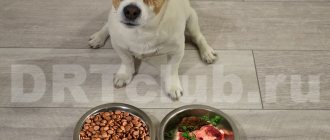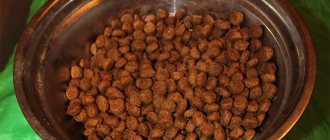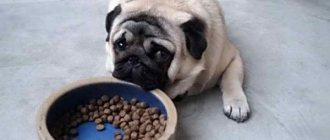Before getting a dog, you need to decide not only on the breed, but also on the upcoming costs of purchasing pet food. Correct calculation of a single serving is also important for the health of the animal, since overfeeding can lead to obesity, and excess weight, in turn, leads to other serious problems.
- 1 How to correctly calculate portions when feeding dogs
- 2 Frequency of feeding dogs
- 3 Diet by age and weight
- 4 Food standards for puppies
- 5 Food standards for adult dogs
- 6 Standards for natural nutrition
- 7 Feeding standards for wet food
- 8 Mr. Tail recommends: rules and regulations for feeding dry food (by breed, age, weight)
What is the relationship between the class of feed and its consumption?
A dog owner should know how to properly feed his pet dry food. There are many different factors to consider and remember that there is no single standard. Even dogs of the same breed require different amounts of food.
A variety of dry food allows you to choose the one that suits your pet best
The amount of feed directly depends on its category. A cheap product has an average composition, it contains few useful substances, it will be digested faster, therefore, the dog needs to be given a larger portion so that it does not remain hungry.
More expensive foods contain more nutrients and fill you up faster. As a result, the dog feels full for a longer time; a small portion is enough to satiate him.
For your information! More expensive products have a better effect on the dog's body, especially during adolescence.
Soaking the feed
If the manufacturer does not indicate restrictions on soaking the feed and such information is not on the packaging, the granules can be soaked. It is especially useful to do this for older dogs, sick individuals and puppies up to three months old.
To do this, you need to fill the granules by half or a third with unboiled drinking water, heated to about 40°C. Boiled milk is sometimes added to the puppy.
Soaked food cannot be stored for a long time - a maximum of three hours. It is dangerous to use it after longer storage, as it turns sour very quickly. Regardless of whether the dog eats dry food or soaked food, the norm is the same.
Feed classes and their energy value
How much dry food does a cat need per day: table
Before choosing a suitable dog food, it is worth understanding that there are several types that differ in calorie content, composition, nutritional value, and protein content. When choosing, it is important to take into account that the more caloric and nutritious the product, the lower the dosage should be.
Note! The most expensive foods, as a rule, have a high calorie content, so a small amount is enough for the dog to get enough.
The choice between dry food and natural food depends on the owner’s preferences
Economy class
To produce feed from this group, the cheapest products are used. The main part is corn and grains. The low meat content is compensated by the increased volume of soy. Such food has a calorie content of no more than 250-300 kcal per 100 g.
Important! When choosing such foods, it is imperative to include additional supplements and vitamin complexes in your pet’s diet.
Premium class
Premium foods include small amounts of vitamins and minerals. The product also contains some protein (approximately 20%), which is produced from offal and meat waste. The composition contains a large amount of corn and other grains. The average energy value of such foods does not exceed 350 calories per 100 g. If necessary, you will need to add additional nutrients to your pet’s diet.
Super premium class
Feeds in this group are distinguished by their increased cost and balanced composition. They contain high amounts of protein, obtained from high-quality meat products. In addition, they include all the necessary minerals and vitamins. There is no soy in such products, and corn is included in the composition in a minimal amount. The value of super-premium food reaches 450 kcal per 100 g, while the dog receives all the necessary substances immediately during meals.
Note! Such products are allowed to be given to the animal constantly. The popular French food Pro Plan falls into this category.
Holistic
For food in the holistic category, only high-quality products are used that are acceptable for use in the food industry. The calorie content is approximately 450 kcal per 100 g. The composition contains all the necessary elements that have a beneficial effect on the dog’s condition. These foods are perfect for pets during pregnancy and for animals with various diseases.
Dogs generally enjoy eating dry food because they often contain flavor enhancers.
How to weigh a pet
You can weigh a large puppy on special scales, which are available in every veterinary clinic. In the case of a small puppy, ordinary floor scales will be sufficient: to do this, you need to take the pet in your arms and weigh yourself with it, then repeat the measurement without it and subtract the second from the first indicator. It is advisable to update weight data at least once a month, and if the pet is prone to obesity or, conversely, does not gain weight well on dry food, then weekly.
Recommended feeding rates
The daily amount of dog food is calculated based on several factors:
- pet's weight;
- age;
- activity;
- tendency to gain excess weight.
How to lose weight for a dog: food and diet for obesity
These indicators are the most important when creating a dog’s diet.
Important! You need to understand that large dogs, such as a husky or a Labrador, will need more food than a Pomeranian.
However, there are some other points to consider:
- presence of pregnancy;
- growth rate (varies among different breeds);
- the presence of diseases or the duration of the recovery period;
- living conditions (animals living outside require more nutrients, especially in winter).
Note! When preparing a diet, you can also consult a veterinarian.
In general, the average daily intake of dry food for adult animals, depending on weight and physical activity, can range from 200 to 900 g per day. In this case, the dog needs to be fed 2 times a day.
Do not exceed the amount of dry food to avoid overeating
For service dogs and athletes, it may be necessary to increase the portion by ⅓ of the total dosage; for pregnant bitches, the amount of food is increased by a quarter. For older dogs, on the contrary, the portion should be reduced by ⅓.
Puppies are fed much more often. At the age of up to 2 months, the frequency is 5-6 times a day, at 3 months - 4-5 times. At the age of 4 months to six months, 3-4 feedings are sufficient. From 6 months to a year, food is given three times a day; after a year, the dog is already an adult, and the frequency of feeding should be appropriate.
Many owners often have a question about how many grams of food per day should be given to the puppy. The amount of food for babies depends on the breed and weight. For small dogs, the portion will be smaller than for puppies of larger breeds. To correctly calculate the amount of food for babies, you will need to know their weight and calorie content of food. Approximate data per 1 kg of weight can be seen in the table below.
| Age | Calorie content (kcal per 100 g) |
| Up to 1 month | 220 |
| Up to 3 months | 270 |
| Up to six months | 150 |
| Up to a year | 120 |
Note! For very young puppies, dry food should be soaked a little in water to avoid damage to the teeth.
On each food package, the manufacturer indicates the recommended amount for the dog depending on its weight. However, you cannot be completely guided by these parameters, because each dog is individual.
The norm for puppies also depends on the weight and age of the baby
How many times a day do you feed a dog?
The frequency directly depends on the age of the animal. Puppies are given shorter intervals between feedings and a larger number of meals.
Puppy
From the age of three weeks, puppies begin to be accustomed to solid food. The number of feedings reaches 5-6 times a day.
Once the puppy reaches two months of age, the number of feedings is reduced to 3-4, after six months of age - to 2. Animals one year old and older, depending on their physical condition, are fed twice a day.
Adult
An adult dog is fed twice a day – in the morning and in the evening. It is necessary to observe a strict interval between serving food - 12 hours - and not move it under any circumstances. The regime can be broken if you need to fast before tests or surgery.
For pregnant females, the frequency of feedings is increased only in extreme cases - usually an increase in portion size is enough.
Adult dogs are fed three to six times a day if they are on a diet to treat a serious illness. When the pet’s well-being improves, the pet is transferred to the usual two meals a day.
Summary table: norms of food of different types for dogs by age and weight
How many times a day should you feed an adult dog and a puppy?
Different types of feed differ in composition and content of vitamins and microelements. The average daily intake of dry dog food is described in the table below using some brands as an example.
| Dog weight (kg) | Economy: Chappie, Pedigree, Our Mark (portion per day) | Premium: Royal Canin, Monge, Proplan (portion per day) | Super-premium: Akana, Grandorf (serving per day) | Holistic: Landor (serving per day) |
| To 10 | Up to 180 | 120 | Up to 150 | 160 |
| 10-20 | Up to 350 | Up to 200 | Up to 290 | 340 |
| 30-40 | Up to 500 | Up to 330 | Up to 400 | Up to 590 |
| 40-60 | 650 | Up to 550 | 510+50 g/5 kg weight | Up to 860 |
Important! For a pregnant dog, the daily intake can be increased by 25-50% after consultation with a veterinarian. It is possible to switch an animal from adult food to puppy food, because it contains more useful substances.
For a nursing dog, it is important that food is constantly available so that it can eat at any time.
When is overfeeding justified?
In adult bitches, the need for nutrients increases greatly during pregnancy and feeding puppies. Many owners switch dogs that are expecting offspring to nutritious puppy food or increase the daily intake to 50%. During lactation, you can even leave food freely available. Insufficient nutrition of a pregnant and lactating dog is fraught with the appearance of weakened offspring, a lack of milk and a decrease in its quality, as well as the occurrence of health problems in the bitch.
How to make the calculation yourself
Calculating the amount of dog food yourself is quite simple and does not require much effort. To get the desired result, you need to divide the daily calorie intake by the energy value of the feed. In addition, it is worth taking into account the weight, age, activity of the pet, and the characteristics of its health. It is also recommended to consult a veterinarian.
Some manufacturers include measuring cups in the packaging
How to determine the weight for one serving
There are several ways to determine the weight of a portion.
- Weighing. After placing a few granules in a bowl, place them on the scale and record the result. Remove/add granules as needed. Be sure to consider the weight of the bowl.
- Use of distributors. You can buy suitable measuring cups or glasses and use them to measure the serving weight.
- Determination by eye. It is acceptable if you have fed the animal several times and can imagine how voluminous this portion looks.
Examples of diet for puppies of different breeds
Puppies of different dog breeds also differ in weight and size. In addition, they grow and develop differently. For some, a small portion of food is enough, while others will need several times more.
Puppies of small breeds (for example, Yorkies) have an accelerated metabolism, so they mature quite quickly. Closer to a year, they can easily be switched to food for adults. Approximate calculations are described in the table.
| Adult dog weight (kg) | 2-3 | 4-6 | 7-9 | 10-13 | 14-16 | 17-19 | 20-22 | 23-25 |
| Puppy age (months) | ||||||||
| 2 | 65 | 100 | 125 | 160 | 190 | 215 | 240 | 240 |
| 3 | 70 | 110 | 145 | 190 | 225 | 255 | 295 | 295 |
| 4 | 75 | 125 | 155 | 205 | 240 | 275 | 315 | 320 |
| 5 | 75 | 125 | 155 | 205 | 245 | 280 | 325 | 335 |
| 6 | 70 | 125 | 155 | 205 | 245 | 280 | 330 | 350 |
| 7 | 60 | 110 | 140 | 185 | 230 | 260 | 325 | 350 |
| 8 | 55 | 100 | 125 | 170 | 210 | 245 | 295 | 315 |
| 9 | 90 | 110 | 150 | 195 | 225 | 265 | 285 | |
| 10 | 90 | 110 | 150 | 175 | 200 | 235 | 250 |
Large dogs (bulldogs, German shepherds, Rottweilers and the like) have a slow metabolism, so they mature later than kids. Despite the fact that the dog looks like an adult, all his organs and skeleton continue to develop, so he needs enough useful nutrients. Veterinarians often recommend giving large dogs puppy food until they reach 2 years of age. An approximate calculation is described in the table below.
| Adult dog weight (kg) | 26-29 | 30-33 | 34-37 | 38-44 | 45-54 | 55-64 | 65-74 | More than 75 |
| Puppy age (months) | ||||||||
| 2 | 255 | 245 | 260 | 295 | 380 | 395 | 415 | 440 |
| 3 | 310 | 315 | 340 | 390 | 450 | 505 | 550 | 580 |
| 4 | 345 | 355 | 390 | 435 | 490 | 555 | 615 | 645 |
| 5 | 390 | 420 | 460 | 515 | 580 | 660 | 730 | 770 |
| 6 | 435 | 460 | 525 | 590 | 655 | 750 | 835 | 880 |
| 7 | 435 | 480 | 525 | 590 | 660 | 755 | 845 | 890 |
| 8 | 405 | 445 | 490 | 585 | 655 | 755 | 850 | 895 |
| 9 | 375 | 415 | 460 | 545 | 675 | 780 | 925 | 975 |
| 10 | 345 | 380 | 430 | 510 | 660 | 765 | 910 | 960 |
| 11 | 315 | 345 | 400 | 465 | 640 | 740 | 890 | 935 |
| 12 | 375 | 425 | 625 | 720 | 860 | 905 |
These are just approximate data. The owner should monitor his pet and, if necessary, slightly reduce or increase the portion.
It is important that your dog always has clean water next to his dry food.
Young and old
Puppies require a lot of energy to develop and grow. Calculate their daily intake based on the recommendations at the bottom of the table, or choose special products for puppies marked Puppy, where the norms are indicated by weight and breed type.
Elderly animals (over 7 years), on the contrary, are prone to obesity due to age-related slowdown of metabolism and decreased physical activity. Some Acana and Orijen lines have special dry food marked Senior, taking into account the biological needs of this particular age category. If the dog is picky about food and is accustomed to a different diet, you can stay on it, slightly reducing the usual rate.
How to measure dry food
It is impossible to accurately measure dry food for an animal without a scale. Therefore, if you want to know the amount of food for sure, you will have to purchase a kitchen scale on which you can measure the portion daily.
For your information! Manufacturers of some expensive dog foods include special measuring cups in the package, with which you can measure the desired portion. However, it is worth remembering that such a measuring container is designed only for this brand, because all dry products have granules of different sizes and weights.
Preliminary data on how much dry food to give a dog per day (table):
| Dog size | Economy, calorie content 280-320 | Premium, calorie content 320-400 | Super-premium, calorie content 400-450 | Holistic, calorie 400-450 |
| Small breeds (up to 12 kg) | Up to 400 g per day | Up to 300 g per day | Up to 200 g per day | Up to 200 g per day |
| Medium breeds (from 12 to 40 kg) | Up to 650 g per day | Up to 450 g per day | Up to 400 g per day | Up to 350 g per day |
| Large breeds (from 40 kg) | Up to 800 g per day | Up to 500 g per day | 450 g per day | 450 g per day |
These are averages and should not be followed exactly, but are best used as a rough guide.
If necessary, a complete diet can be compiled together with a veterinarian. Important! It is imperative that clean water is always available to the dog.
Nutrition rules for large and medium breeds
Representatives of medium breeds have a slower metabolism than small breed dogs, and large breeds have an even slower metabolism. Accordingly, the number of calories needed per unit of body weight is lower. Therefore, the calorie content of feed for them, unlike small ones, should not be high.
Required dry food:
- consisting of medium and large granules;
- average calorie content;
- balanced;
- full-featured;
- containing glucosamine (for joints).
Feeding rules:
- 2 times a day (breakfast and dinner);
- serving food at the same time every day;
- take into account activity and age in dosage;
- do not leave uneaten food in the bowl;
- monitor the presence of substances for joints in the composition.
When choosing food and calculating how much dry food to give per day, be sure to take into account the individual characteristics of your dog.
What to do if your pet eats more or less than normal
Often incorrect calculations lead to the fact that the pet receives less or more than the norm. If a dog is constantly begging for treats, this does not always mean that he is hungry. It is worth taking a close look at the dog’s behavior.
The pet does not have enough portions if:
- after he has eaten, he does not want to leave the bowl;
- his ribs, edges of the shoulder blades and pelvic bones are clearly visible;
- thin layer of fat;
- the hungry pit is quite noticeable.
Based on these signs, you can understand that the dog does not have enough nutrition and nutrients; it is recommended to increase the portion. However, this should be done gradually, without adding a lot of food at once. You may need to switch your pet to another product that is higher in calories, or add various supplements and wet food to the diet.
If the pet does not finish the entire portion, leaves it in the bowl, and the presence of fat on it becomes quite noticeable, then it is worth reducing the portion a little. After eating, the food bowl can remain in place for another 15 minutes. (if there is anything left in it). Then you should remove it and not give anything to the dog until the next feeding.
Excess food leads to obesity in dogs
Important! If the product remains permanently, then the dosage is reduced, but also gradually.
Dry food is an excellent solution for pets. However, it is important for dogs to choose the right product. It is better to give preference to premium and super-premium food because they contain more protein and nutrients. It is necessary to create a dog’s diet taking into account its weight, age and body characteristics. The living conditions of the pet are also taken into account. If such food does not inspire confidence, then you can simply provide your pet with good natural nutrition.
If the dog doesn't eat enough
You can tell that an animal is hungry by its licked bowl and condition. Lethargy and low activity indicate a lack of nutrients. Solutions may vary:
- familiarize yourself with the manufacturer’s recommended dosage and strictly follow the instructions on the packaging;
- change food brand;
- review the feeding schedule and adequately assess the dog’s activity.
If the advice does not help, it is better to contact a veterinarian. The cause of hunger can be helminths and gastrointestinal diseases.
Proper feeding is the key to your pet’s health. You should carefully consider the choice of product brand, its composition and calorie content. Nutrition dosage is a flexible indicator that is adjusted depending on the dog’s condition, its activity, age, and body weight.

